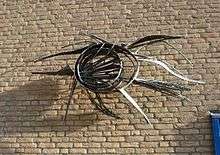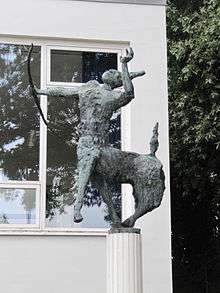New Hague School (visual arts)
.jpg)

.jpg)
.jpg)

The New Hague School (Dutch Nieuwe Haagse School) is a movement in the fine arts of the fifties and sixties of the 20th century. She opposed the Cobra avant-garde movement and found her inspiration in the 17th-century art and the experiences of the Barbizon School and the resulting Hague School.
History
Immediately after the Second World War the The Hague artists came up with their own renewal in painting in addition to the experimental Cobra movement. In 1949 came the first Posthoorn-group, named after the bodega and art gallery named De Posthoorn.[1] This group was disbanded in 1962.
In 1951 came the group Verve, or Hague Verve which focused on the The Hague interpretation of the innovations in the School of Paris, with a modern-figurative art. The group ceased to exist in 1957.
As an almost logical continuation of Verve was the group founded in 1960, named Fugare with emphasis on the non-figurative art. This group existed until 1967.
In 1947 in the Gemeentemuseum Den Haag held an exhibition for artists from The Hague, entitled Haagse Kunstenaars (The Hague Artists). This exhibition concept was repeated another eight times, until 1959. It is quite clear that most of the participants were either part of the Verve group, the Fugare group, and/or the Posthoorn-group. These groups were considered to be the main part of the New Hague School. This term was first used by Jos de Gruyter (1899-1979), chief curator of modern art at the Gemeentemuseum Den Haag and later director.[2]
Participants
Artists from the Posthoorn-group
- Johan van den Berg (1939 -), Jos van den Berg (1905 - 1978), Theo Bitter (1916–1994), Karel Bleijenberg (1913 - 1981), Kees van Bohemen (1928 - 1985), Carolien Boudijn, Amélie de Bourbon (1936 -), Wil Bouthoorn (1916 - 2004), Dirk Bus (1907–1978), Jan Cremer (1940 -), Gerard Fieret (1924 - 2009), Lotti van der Gaag (1923 -2000), Willem Hussem (1900 - 1974), Nol Kroes (1918 - 1976), Joop Kropff (1892 - 1979), (Paul Kromjong (1903 - 1973), George Lampe (1921 - 1982), Hans van der Lek (1936 - 2001), Will Leewens (1923 - 1986), Ber Mengels (1921 - 1995), Theo van der Nahmer (1917 - 1989), Jaap Nanninga (1904 - 1962), Jan Olyslager (1926 - 2010), Thijs Overmans (1928 -), Jan Roëde 1914 - 2007), Marianne de Ruiter 1919 - 1990), Willem Schrofer 1898 - 1968), Wim Sinemus 1903 - 1987), Ferry Slebe 1907 - 1994), Arnold Smith 1905 - 1995), Meike Sund (1923 -), Gerard Verdijk (1934 - 2005), Aat Verhoog (1933 -), Joop Vreugdenhil (1904 - 1969), Karel Wiggers 1916 - 1989), Frans de Wit (1901 - 1981), Aart van den IJssel (1922 - 1983)
The Verve group
The painters:
- Kees Andrea (1914 - 2006), Hannie Bal (1921), Herman Berserik (1921 - 2002), Theo Bitter (1916 - 1994), Querine Collard (1920 - 1963), Rein Draijer (1899 - 1986), Jan van Heel (1898 - 1990), Nol Kroes (1918 - 1976), Willem Minderman (1910 - 1985), Henk Munnik (1912–1997), Rinus van der Neut (1910 - 1999), Willem Schrofer (1898 - 1968), Ferry Slebe (1907–1994), Frans Vollmer (1913 - 1961), Co Westerik (1924) en Frans de Wit (1901 - 1981).
And the sculptors:
- Hubert Bekman, (1896 - 1974), Dirk Bus (1907 - 1978), Theo van der Nahmer (1917 – 1989), Rudi Rooijackers (1920 - 1998) en Bram Roth (1916–1995).
Artists, that later joined the group:
- Wil Bouthoorn (1916 - 2004), George Lampe (1921 - 1982), Christiaan de Moor (1899 – 1981) en Aart van den IJssel, (1922 - 1983).
The Fugare group
- Theo Bitter, Harry Disberg, Jan van Heel, Willem Hussem, Nol Kroes, Joop Kropff, George Lampe, Christiaan de Moor, Theo van der Nahmer, Jaap Nanninga, Wim Sinemus, Gerard Verdijk, Frans de Wit and Aart van den IJssel.
Contemporaries
Some of contemporary artists, which can be considered part of the New Hague School, but didn't joined Verve, Fugare and the Posthoorn-group, such as:
- Kees Andréa, Livinus van de Bundt, Paul Citroen, Harm Kamerlingh Onnes, Toon Kelder, Piet Ouborg, Willem Rozendaal, Albert Termote, Jules Vermeire, Kees Verschuren, and Toon Wegner.
Furthermore, also some of the contemporaries, who exhibited at the art gallery De Posthoorn, such as:
- Johan van den Berg, Karel Beijenberg, Thaddeus van Eijsden, Jan Goeting, Hens de Jong, Jan Kuiper, Thijs Overmans, Harry Verburg, Karel Wiggers and Ans Wortel.
See also
References
- ↑ Jan Cremer, Pierre Restany, Freddy de Vree (1998). Cremer: grafiek, 1956-1998. p. 18
- ↑ WJ de Gruyter and Paul Rodenko (1952), Verve.
Further reading
- Ton Knoester, Roelie Knoester-Penninkhof. Nieuwe Haagse School. Published by: Scriptum Art, Schiedam and Foundation New Hague School, The Hague (2002) ISBN 90 5594 272 3
External links
- (Dutch) Moderne Haagse Kunst en Nieuwe Haagse School at nieuwehaagseschoolkunst.nl